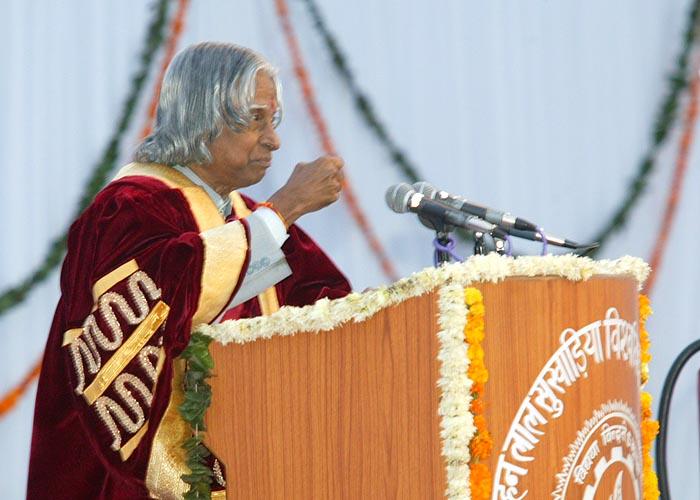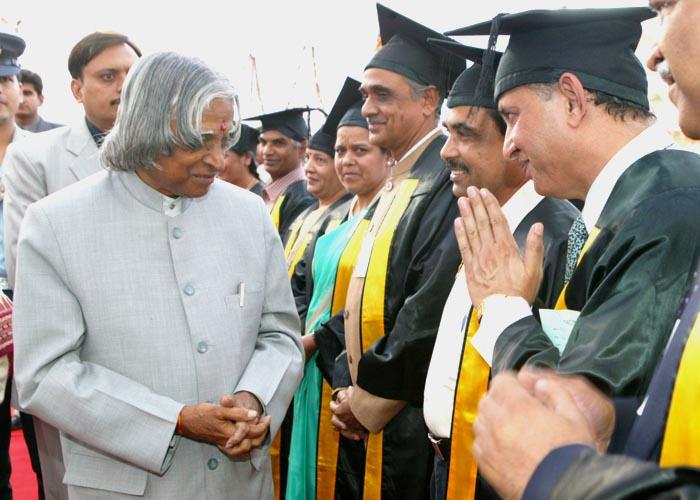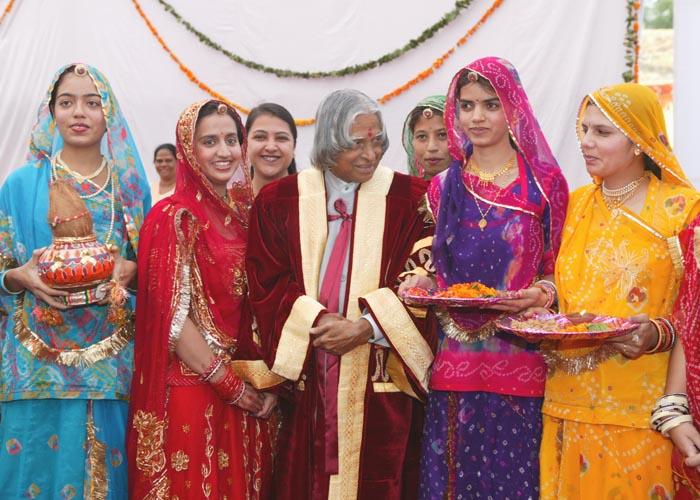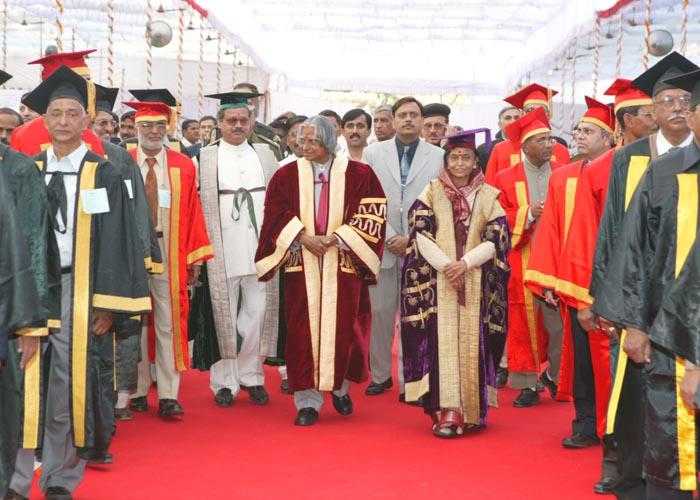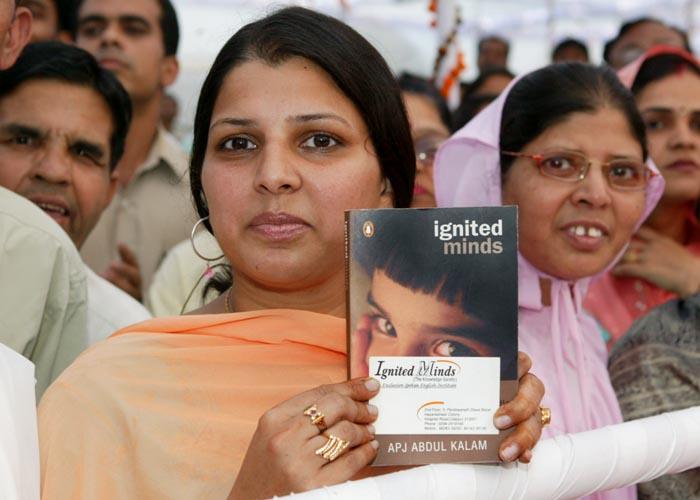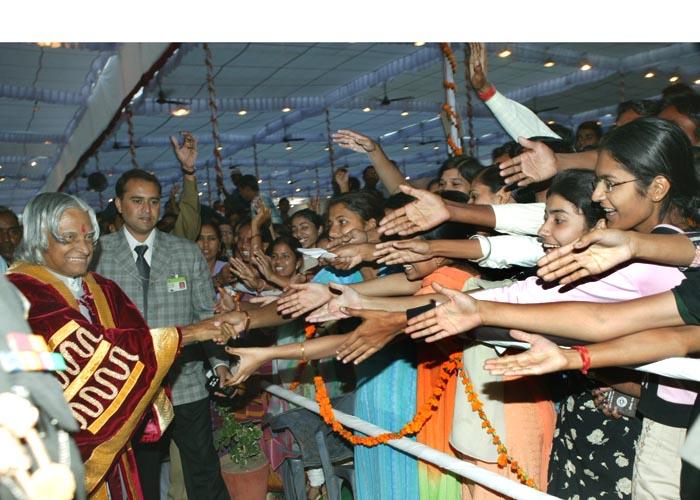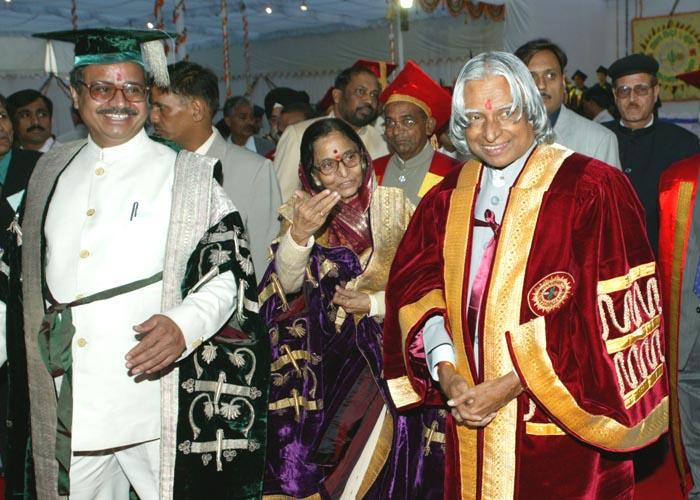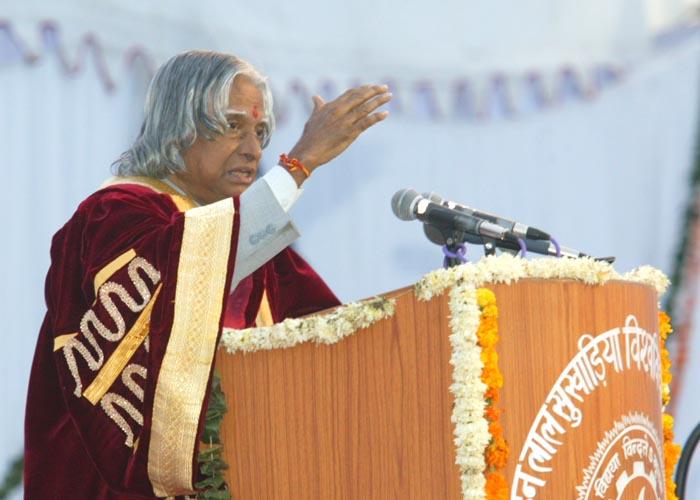Xvi Convocation Address At The Mohanlal Sukhadia University
Udaipur : 23-11-2004
Youth and National Development
I am indeed delighted to participate in the sixteenth Convocation of the Mohanlal Sukhadia University. I take this opportunity to wish the University students for their academic performance. I greet the Chancellor, Vice Chancellor, Professors, teachers and staff for shaping the young minds to contribute to the nation in multiple fields. Dear graduates, when you go out of this university, the education and empowerment that you have received will be with you to meet any challenge. You will be a winner if you have a tall aim, if you can sweat for achieving the aim and indomitable spirit to overcome any problem you face in your life.
Our National mission - challenges
Our nation is going through a major challenge of uplifting of 260 million people who are below the poverty line. They need habitat, they need food, they need health care, and they need education and employment and finally resulting in a good life. Our GDP is growing at more than 6% per annum. Whereas, the economists suggest that to uplift the people below poverty line, our economy has to grow at the rate of 10% per annum consistently, for over a decade.
Integrated action: To meet the need of one billion people, we have the mission of transforming India into a developed nation. We have identified five areas where India has a core competence for integrated action: (1) Agriculture and food processing (2) Reliable and Quality Electric power, Surface transport and Infrastructure for all parts of the country. (3) Education and Healthcare (4) Information and Communication Technology (5) Strategic sectors. These five areas are closely inter-related and if well done would lead to national, food, economic and security.
Essential Connectivities: The integrated methods, which will bring prosperity to rural India are: the physical connectivity of the village clusters through quality roads and transport; electronic connectivity through tele-communication with high bandwidth fiber optic cables reaching the rural areas from urban cities and through internet kiosks; knowledge connectivity through education, vocational training for farmers, artisans and craftsmen and entrepreneurship programmes; these three connectives leading to economic connectivity through starting of enterprises with the help of banks, micro credits and marketing the products.
Now let us discuss how the student community can acquire the capacities required for national development during their education period.
Capacity building model
When the students come out of the University certain capacities are required to be built in them for enabling them to face the challenges in the real world, in their professional career and also facilitate their participation in the task of national development. I suggest that the ingredients for capacity building must be embedded right from the beginning of the students? life. A good educational model is the need of the hour to ensure that the students grow to contribute towards the economic growth of a nation. I am sure that the University has been paying attention to this need over the years. This can, however, be reinforced and be the mission of the University.
For participating in the nation building tasks, the capacities required to be built among the students in their formative years by the educational institutions are: The capacity for research or inquiry, the capacity for Creativity and Innovation, particularly the creative transfer of knowledge, the capacity to use high technology, the capacity for Entrepreneurial Leadership and the capacity for Moral Leadership.
Research and enquiry
The 21st century is about the management of all the knowledge and information we have generated and the value addition we bring to it. We must give our students the skills with which they find a way through the sea of knowledge that has been created and continue with life long learning. Today, we have the ability, through technology, to really and truly teach ourselves to become the life-long learners. This is required for sustained economic development.
As an example, I would like to share with you the discussion I had with one of my friends on how to activate both sides of the brain in a balanced way, so that the child can have concentration and high efficiency learning. We have discussed about the use of abacus in developing the capability of the child. Immediately I searched for the information on abacus and its tools available in the internet. I got number of sites that provide simulated training through computers and animated packages for self learning and also various other related tools in the form of mathematics games which makes the learning process a beautiful experience. The faculty members should inculcate this capacity of inquiry among the students and the University must provide the environment and infrastructure for the students to learn by themselves with the help of live examples.
Creativity and innovation
The management of knowledge in the 21st century is beyond the capacity of a single individual. The amount of information that we have around us is overwhelming. The management of knowledge therefore must move out of the realm of the individual and shift into the realm of the networked groups. The students must learn how to manage knowledge collectively. When the information is networked the power and utility of the information grows as squared as predicted by Metcalfe's law. Information that is static does not grow. In the new digital economy, information that is circulated creates innovation and contributes to national wealth.
Capacity to use high technology
Every student in our colleges and university should learn to know how to use the latest technologies for aiding their learning process. University should equip themselves with adequate computing equipment, laboratory equipments, and Internet facilities and provide an environment for the students to enhance their learning ability. In the midst of all of the technological innovations and revolutions, we cannot think that the role of the teachers will be diminished. In fact the teacher will become even more important and the whole world of education will become teacher assisted and would help in ?tele-porting? the best teacher to every nook and corner of the country and propagate the knowledge.
Entrepreneurship
The aptitude for entrepreneurship should be cultivated right from the beginning and in the university environment. We must teach our students to take calculated risks for the sake of larger gain, but within the ethos of good opportunities. They should also cultivate a disposition to do things right. This capacity will enable them to take up challenging tasks later.
Moral leadership
Moral leadership involves two aspects. First it requires the ability to have compelling and powerful dreams or visions of human betterment. Moral leadership requires a disposition to do the right thing and influence others also to do right things. Civilizational heritage and derived value system will be foundation for the moral leadership.
In sum, inquiry, creativity, technology, entrepreneurial and moral leadership are the five capacities required to be built through the education process. If we develop in all our students these five capacities, we will produce ?Autonomous Learner? a self-directed, self controlled, lifelong learner who will have the capacity to both, respect authority and at the same time is capable of questioning authority, in an appropriate manner. These are the leaders who would work together as a ?Self-organizing Network? and transform any nation into a developed nation in a time bound manner.
Literacy Mission
Mohanlal Sukhadia University can deploy the students and staff of the University in adult literacy mission for creating enlightened citizens in this region. You should look beyond the campus and see in what areas we have to assist the society. One of the possible schemes, you can undertake an out reach programme on literacy mission for the tribal region. You have around 70 colleges apart from the University Campus with a student strength of 80,000. You can cover literacy programme of the six districts (Udaipur, Dungarpur, Banswara, Chittorgarh, Rajsamand and Sirohi) having a population of over ninety lakhs. Out of this population, the adults in the age group of 15 to 35 who need education is around 4 lakhs. If each student in the University with the guidance of the professors can undertake to educate at least 2 adults per year who cannot read and write the total number of people who can be educated per year will be 1,60,000. In a three year period you can definitely educate all the four lakh adults who need education. This will be a creditable achievement for the University.
Employment Generation through Entrepreneurship
There has been substantial growth in our higher educational system and the University is generating over twenty five thousand graduates every year and overall for the whole country it is around 3 million per year from 300 Universities. However our employment generation system is not in a position to absorb the graduates passing out from the university leading to increase in educated unemployed in the region year after year. There is a large mismatch between the skills required for the modern economy and the education imparted to most of these students. In addition, economic growth and investments have not kept pace with the availability of human resources. This situation will lead to instability in the social structure. We need higher education focused on and oriented towards high value and productive employment opportunities. A three pronged strategy is needed to make education more attractive, make it skill imparting and simultaneously create employment generation potential ? how do we do that?
Firstly, the educational system should highlight the importance of entrepreneurship and prepare the students right from the college education to get oriented towards setting up of the enterprises which will provide them creativity, freedom and ability to generate wealth. Diversity of skills and perseverance in work makes an entrepreneur. It should be taught to all the students. In addition, college syllabi even for arts, science, and commerce courses should include topics and practical where such entrepreneurship is possible.
Secondly, the banking system should provide venture capital right from every village level to the prospective entrepreneurs for undertaking new enterprises.
Thirdly, there has to be an economic pull for human resources; for example generation of marketable products and enhancement of purchasing power among the people through the implementation of national missions. The educational institutions, Government and the private enterprises should become facilitators for creating this entrepreneurship scheme through the support of the banking system and the marketing system. Entrepreneurs have to produce the competitive products for becoming successful in their missions. I am sure that capacities will be built among many of the graduates for becoming entrepreneurs by this university and make him an employer rather than the employee.
Opportunities and Challenges for Youth
India has a population of one billion people. Out of this one billion, 540 million people are below the age of 25 years, which is our national strength and also we have natural resources. Also we have a road map for transforming India into a developed nation by the year 2020. Ignited minds of the 540 million youth will definitely transform India into a developed country by the year 2020. Development involves generation of mega missions: PURA, Waste Land Development, Revival of water bodies, power missions, water missions including interlinking of rivers, ICT, tourism, Infrastructure and Pharma. All of them will provide challenging employment opportunities for our youth.
Now I would like to discuss some of the models, which can enable development of rural Rajasthan.
Model for Tribal Rehabilitation Dry Regions:
Today, food security and self-employment with good income is more crucial in Rajasthan. I would like to share with you an integrated village cluster development programme which I experienced during my visit with Dr. Narayan G Hegde, an IIM graduate who is an expert in farming and Dairying, two village clusters of south Gujarat - Chonda and Lachakadi, with a population of 5000. In these villages every summer the tribal people migrate to nearby towns. The Bharatiya Agro-Industries Foundation (BAIF) model was installed in these two villages with peoples? co-operation and the participation of state authorities. Firstly water harvesting was undertaken to get water for every individual. Every home was provided with livestock and also a market for milk. Simultaneously, fruit orchards were established with various fruit crops such as cashew and mangoes, which are tolerant to drought. When I visited, these villages, there was a connecting road and water ponds. The tribal population, with radiant smiles on their faces, was harvesting crops, packaging and carrying milk to different supply points. I happened to see the economic growth and prosperity of the tribal people, which has been facilitated by BAIF with people?s participation. I understand that this model ? Vadi (Orchard) has now been replicated in many places by the state governments of Maharashtra, Gujarat and Rajasthan.
I was told that the project was implemented through Self Help Groups (SHGs) by building mutual confidence. The groups took the responsibility to help the weaker members. This boosted progress. The results were phenomenal. In Ghatol cluster in Udaipur out of 3000 poor families, more than 90% were able to earn Rs. 20,000 per annum. Efficient watershed development not only helped to ensure the availability of safe drinking water throughout the year but also boosted their crop yields from 30% to 80%. Over 800 hectares of Anola orchards were established for the first time in the region, which started yielding from the third year. The farmers group have started processing and marketing the fruits. The entire village cluster was self-sufficient in food supply. Dairy and animal husbandry further boosted their family income from 30 to 60%. These families had formed 71 Self Help Groups and 24 village level organizations. They have built their own corpus of Rs. 30 lakhs. Similar success was achieved in Banswara district. In Gokulpura cluster in Bundi district in Rajasthan, watershed based multi-disciplinary development facilitated the local farmers to grow two crops during the year while the entire district was receiving food aid under the drought relief. This happened in a region where the average annual rainfall is less than 700 mm and the region was facing chronic drought successively for a number of years.
Biofuel Plant- Jatropha
Rajasthan has 52 lakh hectares of cultivable waste land. Certain multi-purpose trees such as Jatropha can grow well in wasteland with very little input. Once grown the crop has a fifty years of life. Fruiting can take place in this plant in two years. It yields upto five tonnes per hectares oil seeds and produces two tones of bio-fuel. Presently, the cost of biofuel through the plant is approximately Rs. 17 to Rs. 19 per liter which can be substantially reduced through choice of right size of the plant and using high yield variety plantation which has already been established by the researchers. Biofuel plants grown in 11 million hectares of land can yield a revenue of approximately Rs. 20,000 crore a year and provide employment to over 12 million people both for plantation and running of the extraction plants. This is a sustainable development process leading to large-scale employment of rural manpower. Also, it will reduce the foreign exchange outflow paid for importing crude oil, the cost of which is continuously rising in the international market. Use of Biofuel is Carbon mono-oxide emission free. This oil can also be used for soap and candle industries. De-oiled cake is a raw material for composting and plantation is good for honey production. We should absorb best of the technologies available worldwide and start commercial operation soon, instead of staying at pilot plant levels. The University can work with institutions like BAIF, other NGOs, industrial partners and banks for undertaking bio-fuel enterprises in this belt.
Conclusion: Creative Leadership
There are 540 million youth below 25 years in the population of a billion people. The nation needs young leaders who can command the change for transformation of India into a developed nation embedded with knowledge society. The leaders are the creators of new organizations of excellence. Quality leaders are like magnets that will attract the best of persons to build the team for the organization and give inspiring leadership even during failures of missions, as they are not afraid of risks. I have seen and worked with creators of vision and missions.
One of the very important ingredients for success of the vision of transforming India into a developed nation by 2020 is the evolution of creative leaders. I am giving a connectivity between developed India, economic prosperity, technology, production, productivity, employee role and management quality, all of which linked to the creative leader. Who is that creative leader? What are the qualities of a creative leader? The creative leadership is exercising the task to change the traditional role from commander to coach, manager to mentor, from director to delegator and from one who demands respect to one who facilitates self-respect. The higher the proportion of creative leaders in a nation, the higher the potential of success of visions like ?developed India.?
The mission of Mohanlal Sukhadia University is the creation of righteous creative leaders who will be primarily participating in the transformation of the six districts viz. Udaipur, Dungarpur, Banswara, Chittorgarh, Rajsamand and Sirohi into a prosperous, happy and strong region as part of the mission of National Development.
I congratulate the students who have been awarded degrees during this convocation. My best wishes to all the members of this university for success in their missions.
May God bless you.

